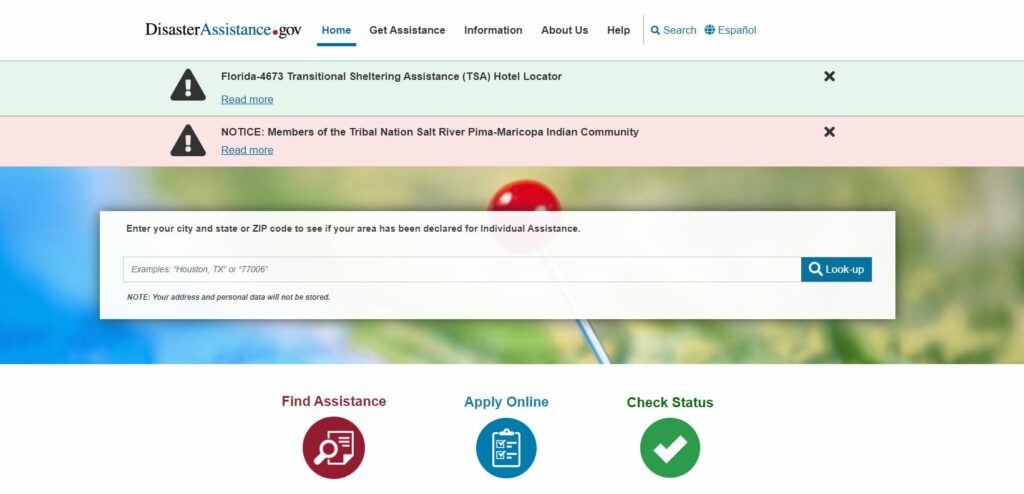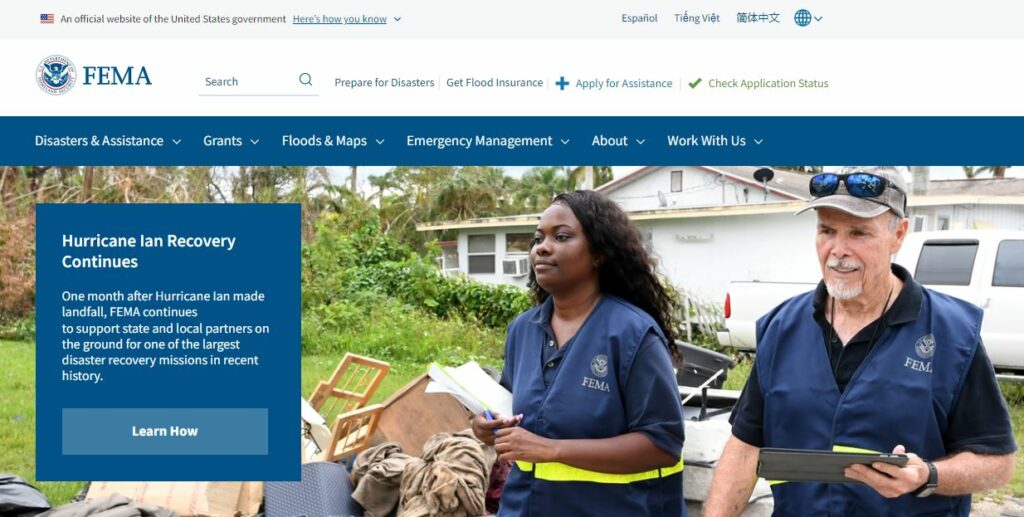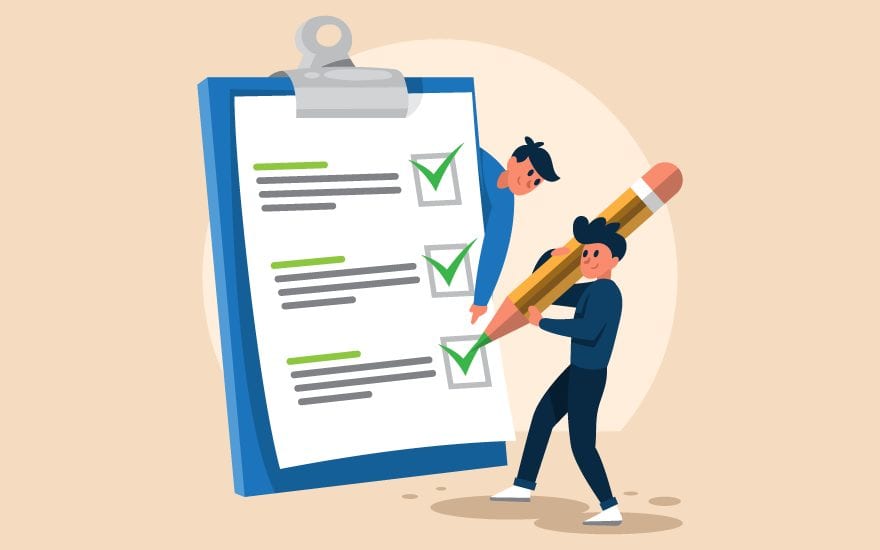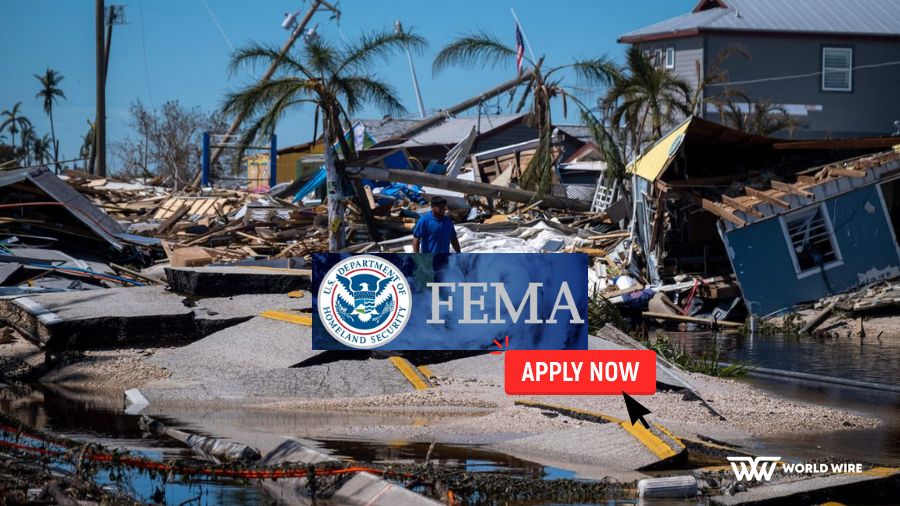How to apply for FEMA Assistance – If Hurricane Ian hit your hometown, and you were a resident of Charlotte, Collier, DeSoto, Hardee, Hillsborough, Lee, Manatee, Orange, Osceola, Pinellas, Polk, Sarasota, or Seminole County, FEMA could be of assistance in that scenario.
If you need help paying for emergency lodging, repairing your house, or anything else your insurance won’t cover, you can apply to FEMA for Assistance.
Here is the detailed information about how to apply for FEMA Assistance after Hurricane Ian –
How to apply for FEMA Assistance Program after Hurricane Ian

Visit www.disasterassistance.gov, call 800-621-3362 between 7 AM and 11 PM Eastern Time or use the FEMA mobile app to apply for disaster aid. You have to provide FEMA with the contact information for any relay services you utilize, such as video relay service, captioned telephone service, or others.
Have the following ready when you submit your application for help –
- Up-to-date contact numbers
- Both your pre-disaster and current addresses
- Your Social Security Number
- Losses and damages in general
- Your bank details for direct deposit
- If you’re insured, include details about your policy, broker, or insurer, and please keep in mind that damages compensated by insurance are not eligible for FEMA compensation.
What is FEMA Assistance Program?

In 1979, President Carter issued an executive order creating the Federal Emergency Management Agency (FEMA) to aid Americans “before, during, and after disasters.” The agency achieves this goal by providing services to businesses, communities, and individuals, such as direct assistance, grants, risk management, and other programs.
Before FEMA existed, over a hundred distinct government departments and agencies helped during natural disasters like fires and earthquakes. People demanded a more simplified method since they found it difficult to coordinate relief operations with many agencies.
To accomplish this goal, President Carter merged several agencies into a single entity, and since its inception, FEMA has been in charge of emergency planning.
To fulfill its mandate, FEMA –
- Creates a culture of readiness across the country
- Creates programs to provide food and shelter in times of crisis
- Builds disaster-proof communities and codes
- Takes Charge of the National Flood Insurance Program (NFIP)
- Examines the disaster’s devastation in its early stages
- The provision of financial aid for restoring damaged homes and communities following natural or man-made disasters.
How Does FEMA Work?
FEMA’s strategic plan for 2018–2022 consists of three pillars supporting the agency’s fundamental mission. These aims are made to aid people at any point during an emergency. To achieve these objectives, FEMA collaborates with disaster response teams from other levels of government, including the federal, state, municipal, and tribal levels.
The following are the three pillars of FEMA
Building a Culture of Preparedness
To do this, individuals and communities must become familiar with the dangers unique to their area and work together to develop contingency plans.
Preparing the Nation for Catastrophic Disasters
Building a national incident workforce of emergency professionals and first responders to carry out operations during disaster response and recovery is a key part of preparing the United States for possible catastrophic events.
Reduce the Complexity of FEMA
The goal of “Reduce the Complexity of FEMA” is to make it easier for employees, survivors, and those applying for grants to receive funding in times of crisis.
How do you apply for FEMA Assistance?
Federal Emergency Management Agency (FEMA) aid can be available to those who have been affected by a catastrophe but who do not have enough insurance coverage.
The application process and information about eligible programs are accessible online at DisasterAssistance.gov.
They have a wide range of financial and assistance options. FEMA’s eligibility determination takes into account your needs.
How to apply for FEMA Assistance Program after Hurricane Ian?
After a catastrophe, FEMA can award numerous different sorts of funding.
- Public Assistance aids state, municipal, and tribal governments as well as some private nonprofit groups.
- Hazard Mitigation aids state, local, tribal, and territorial governments in lowering long-term risk.
- Individual Assistance aids people and families.
Individual Assistance (IA)
The goal of FEMA’s Individual Assistance program is to assist disaster survivors in meeting their immediate, non-reimbursable needs, such as finding a temporary, safe, and hygienic place to reside while they look for a more permanent solution to their housing situation.
It’s not meant to compensate for the loss of income or other assets or replace insurance.
Public Assistance (PA)
Churches and other religious institutions can apply for public assistance funds to help with debris clearance, emergency protective measures, and the repair, replacement, or restoration of public structures destroyed in a natural disaster. As part of a cost-sharing arrangement, the federal government contributes at least 75% of the total allowed expense when providing public assistance.
The two main types of public assistance are –
Emergency work addresses an immediate threat –
- Removing Debris
- Taking Emergency Safety Precautions
Permanent work covers the restoration of –
- Bridges and roads and Water management systems
- Construction and Machinery
- Utilities
- Recreational and public parks
- While rebuilding, the PA program promotes taking precautions to ensure damaged facilities are safe from future disasters.
Hazard Mitigation
The word “hazard mitigation” refers to the ongoing process of lessening or eliminating the potential for harm to people and property caused by future disasters.
The following are part of HM –
- Public Aid (PA) Mitigation Analysis and Risk Assessment
- Identifying the effects of natural disasters and developing viable methods for mitigating risk
- Help with Funding and Strategy
- It helps grantees create and maintain action plans for responding to disasters and gives them the resources they need to spend their money wisely.
- Regulation of Flood Risks and Insurance Coverage
- Technical assistance is provided by floodplain management to ensure that rebuilding and relocation projects comply with National Flood Insurance Program rules.
- It allows municipalities to enforce state and local construction rules and floodplain management regulations.
Hazard Mitigation Grant Program (HMGP)
Following a disaster, state, local, tribal, and territorial governments are eligible for assistance under FEMA’s Hazard Mitigation Grant Program to aid in rebuilding efforts that minimize damage sustained in subsequent disasters.
Grants from Hazard Mitigation are not available to homeowners or commercial enterprises. It’s possible, though, for a neighborhood group to submit a grant application on their behalf.
The HMGP helps communities recover and rebuild more securely. Examples of projects that qualify for HMGP funding are –
- Buying up potentially dangerous properties so their owners can move elsewhere.
- By raising buildings above predicted flood levels, damage can be limited or avoided entirely.
- Rebuilding a flooded home on stilts eliminates or greatly decreases damage caused by flooding in the future.
Eligibility Criteria for FEMA Assistance

FEMA checks applications for the individuals and households program to ensure basic requirements are completed before deciding whether or not to grant aid. An applicant for FEMA aid must swear (under penalty of perjury) that all statements made in the application are true.
Requirements for eligibility in the Individuals and Household Program –
Verifying the individual’s eligibility and the declaration of a disaster are prerequisites for receiving any individual assistance through the program. All applicants must meet these standard requirements before being considered for assistance under the federal government’s Individuals and Households Program.
Citizenship Status
You must verify your status as a citizen, national, or qualifying non-citizen of the United States before applying for benefits.
Identity Verification
FEMA cannot process an applicant’s identity without a valid Social Security Number. FEMA usually conducts identification verification at the time of application via a computerized public record search and a series of questions related to the applicant’s credit file or public records. If FEMA cannot confirm an applicant’s identity through these channels, the applicant may be asked to provide additional proof.
Evidence of Occupancy or Ownership
FEMA must confirm the applicant’s residency or ownership status. Applicants must show that the damaged property served as their principal residence before the event and present proof of home ownership before the disaster.
At the time of application, FEMA conducts a computerized public records check to confirm occupation and ownership, and if FEMA is unable to confirm an applicant’s residency or ownership independently, the applicant can submit supporting proof.
Take a look at all your paperwork to ensure you have all you need to prove your residency or ownership.
Unmet Need After Insurance
You can only apply for FEMA’s Individuals and Households Program if you’ve exhausted all other disaster aid options and your insurance coverage still needs to cover all of the costs and critical needs that resulted from the disaster.
All applicants must notify FEMA of any insurance policies that might cover disaster-related expenses. Before FEMA would evaluate an insured applicant for assistance, the applicant must produce proof of any insurance settlements or benefits received due to disaster-related damage covered by an insurance policy.
Apply for Assistance
If the points mentioned above describe you, visit DisasterAssistance.gov to submit an application for help through FEMA’s Individuals and Households Program. A phone call or in-person application is also acceptable.
FEMA’s Legal Requirements
As a condition of providing aid, FEMA needs to verify that the funds were not already in use, that they were utilized for disaster-related expenses and needs, and that they were not obtained dishonestly. An applicant for FEMA aid must swear (under penalty of perjury) that all statements made in the application are true.
FEMA may consult third-party sources to ensure the data entered is correct. Members of FEMA are obligated to report fraud suspicions to the OIG of the Department of Homeland Security.
The OIG investigates potential fraud cases, and when necessary, they are forwarded to the Department of Justice for further prosecution. When it is necessary for FEMA to pursue recoupment of any assistance obtained through fraudulent means vigorously, FEMA will also initiate collection of any potential debt, regardless of the debt’s value.
Frequently asked questions
How FEMA helps before an Emergency?
FEMA informs the public before a disaster strikes so that people can better prepare themselves, their families, and their communities. In addition, the National Preparedness Goal established by FEMA stresses the need for the country to be ready to respond to any emergency, be it a natural disaster, a pandemic, or an act of terrorism.
How FEMA helps during an Emergency?
The governor of the state hit by a disaster is responsible for petitioning the president to proclaim a state of emergency. FEMA can begin aid operations after the president declares a proclamation.
Assisting local officials in preliminary damage assessments for a presidential disaster declaration is a service provided by FEMA’s regional offices. This analysis considers the disaster’s effects on individuals and the potential forms of federal aid that could be of assistance.
How FEMA helps after an Emergency?
When a crisis ends, FEMA collaborates with local and state organizations to repair the region. Households that have been damaged or displaced as a result of a disaster are primarily served by the Individuals and Households Program (IHP). FEMA’s Housing and Shelter Assistance and Other Needs Assistance make up most of the IHP.
If a homeowner is uninsured or underinsured, the Sheltering and Housing Assistance program can help them pay for repairing or replacing their home. In the event of a natural disaster that forces you to relocate, it can also assist with rent payments. The FEMA ONA program helps with critical post-disaster needs. Childcare, medical and dental bills, funeral expenses, car repairs, and other emergency expenditures fall under this category.
FEMA Hurricane Ian Clean Up Jobs
FEMA is offering locals jobs in clean up and other sectors. Here we have a detailed guide on how to get FEMA Hurricane Ian Clean Jobs.
You may like to read –
Table of Contents







Add Comment